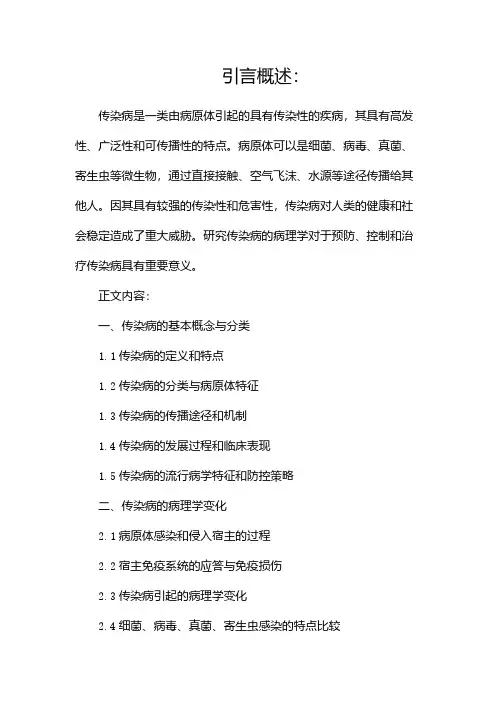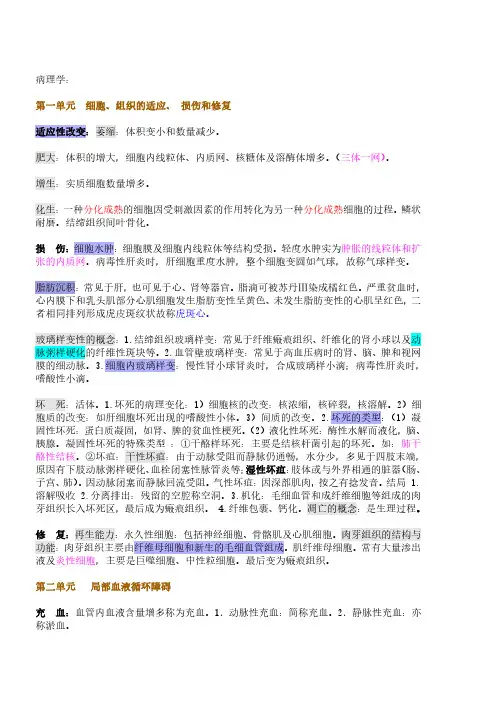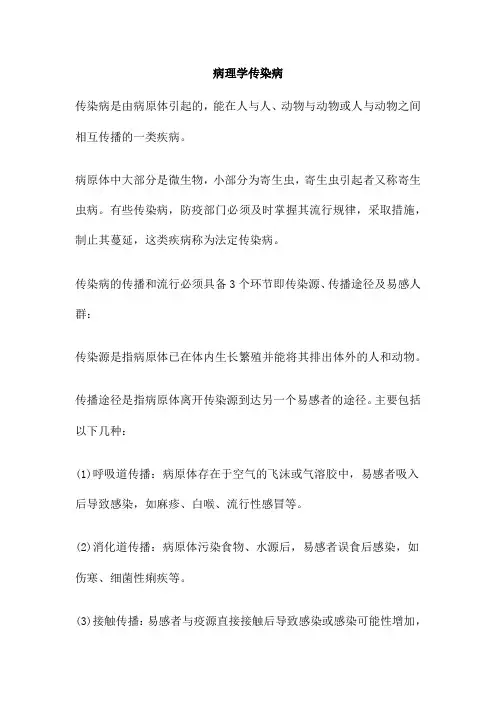病理学第十章传染病
- 格式:doc
- 大小:29.50 KB
- 文档页数:2

传染病结核病Tuberculosis•概述: 结核病是由结核杆菌引起的一种慢性传染病。
•病变特点–组织内形成肉芽肿性病变,即结核结节,伴干酪样坏死。
•临床表现–低热、盗汗、食欲不振、消瘦、血沉加快等病因•病原菌–结核分枝杆菌人型和牛型。
–致病力与菌体成分有关•脂质、蛋白质和多糖类•传播途径–主要经呼吸道传染;少数经消化道发病机制•以细胞免疫为主。
•在感染局部由巨噬细胞聚集而形成的肉芽肿—结核结节•人体感染结核杆菌2—6周后出现细胞免疫反应,同时也发生变态反应,后者造成广泛的组织坏死。
•免疫反应和变态反应同时贯穿在结核病的发生发展过程中结核病的基本病变•特殊性炎症,肉芽肿性病变–结核结节(tubercle)渗出性病变•发生条件–结核病早期或免疫力低下,菌量多或变态反应明显时•病理表现–浆液、纤维素性炎–早期有中性粒细胞浸润,很快被巨噬细胞取代渗出性病变•部位–好发于肺、浆膜、滑膜、脑膜等(与组织特性有一定关系)•转归–完全吸收—增生为主–变态反应剧烈—变质坏死为主增生性病变•发生条件–菌量少,毒力低,免疫力强•病理变化–形成结核结节结核结节tubercle•镜下–结节中央可见干酪样坏死–周围有巨噬细胞、放射状排列的上皮样细胞、郎罕(Langhans)巨细胞–外周的淋巴细胞,少量成纤维细胞结核结节•肉眼–灰白色、粟粒大小,境界清楚,干酪样坏死多时呈淡黄色。
•转归–进一步好转,上皮样细胞→成纤维细胞,结核结节纤维化Note the rounded, focal nature of these granulomas at low power magnification.Elongated epithelioid cells, which are transformed from macrophages, as well as a Langhans giant cell (a committee of macrophages with the nuclei arranged at the periphery) are shown here.坏死为主的病变•发生条件–细菌数量多,毒力强,免疫力低或变态反应强•病理表现:干酪样坏死caseous necrosis–肉眼—淡黄色,均匀细腻,质地较实,状似奶酪–镜下—红染无结构颗粒状物Note the pink, amorphous region in the center of this granuloma at the upper right, and ringedby epithelioid cells at the left and lower areas of this photomicrograph. This is the microscopic appearance of caseous necrosis.结核病基本病变的转化规律•1 转向愈复•(1)吸收消散•(2)纤维化、纤维包裹、钙化•2 转向恶化•(1)病灶扩大,浸润进展•(2)溶解播散肺结核病原发性肺结核病•机体第一次感染结核杆菌引起的肺结核病•又称儿童型肺结核病病变特点•肺的原发病灶、引流淋巴管炎、肺门淋巴结结核三者合称为原发综合征(primary complex) •X—ray 呈哑铃状阴影•临床表现:症状轻微而短暂发展和结局•(1)自然痊愈–纤维化和钙化•(2)恶化进展–支气管淋巴结结核–肺内或全身粟粒性结核✧淋巴道播散:淋巴结结核•镜下:淋巴结结核结节形成,干酪样坏死•肉眼:淋巴结肿大,粘连,干酪样坏死✧支气管播散•→形成空洞。


引言概述:传染病是一类由病原体引起的具有传染性的疾病,其具有高发性、广泛性和可传播性的特点。
病原体可以是细菌、病毒、真菌、寄生虫等微生物,通过直接接触、空气飞沫、水源等途径传播给其他人。
因其具有较强的传染性和危害性,传染病对人类的健康和社会稳定造成了重大威胁。
研究传染病的病理学对于预防、控制和治疗传染病具有重要意义。
正文内容:一、传染病的基本概念与分类1.1传染病的定义和特点1.2传染病的分类与病原体特征1.3传染病的传播途径和机制1.4传染病的发展过程和临床表现1.5传染病的流行病学特征和防控策略二、传染病的病理学变化2.1病原体感染和侵入宿主的过程2.2宿主免疫系统的应答与免疫损伤2.3传染病引起的病理学变化2.4细菌、病毒、真菌、寄生虫感染的特点比较2.5传染病的病理诊断和鉴别诊断三、典型传染病的病理学特点与机制3.1疟疾的病理学特点和致病机制3.2肺结核的病理学变化和发展过程3.3流行性感冒的病理学特征和临床表现3.4急性病毒性肝炎的病理学变化和临床意义3.5艾滋病的病理学特点和免疫损伤机制四、传染病的病理检测和防控措施4.1传染病的病理检测方法和意义4.2传染病的传播途径控制和个人防护4.3传染病的筛查、检测和监测体系的建立4.4传染病的疫苗研发和机制研究4.5传染病的药物治疗和传播阻断措施五、传染病的病理学研究进展与展望5.1传染病病理学研究的现状和问题5.2传染病病理学新技术和方法的应用5.3传染病病理学研究对疫情预测和防控的作用5.4传染病病理学研究的未来发展方向5.5传染病病理学研究的意义和应用前景总结:病理学作为传染病研究的重要分支,对于传染病的预防、控制和治疗具有重要意义。
本文分别从传染病的基本概念与分类、病理学变化、典型传染病的病理学特点与机制、病理检测和防控措施以及病理学研究进展与展望五个大点进行了详细阐述。
传染病的病理学研究可以帮助我们揭示病原体感染和宿主免疫应答的机制,进一步完善传染病的预防、控制和治疗策略,为保障人类的健康和社会稳定做出更大的贡献。






Infectious DiseasesInfectious disease➢Infectious diseases are a group of diseases caused by pathogenic organisms and can be epidemic among certain population.➢Necessary factors for transmission of infectious disease❿Source of transmission❿Routes of transmission❿Susceptible hostRoutes of entry and dissemination of microbes➢Epidemiology: infectious disease is a public condition associated with the socioeconomic conditions.➢The organisms producing diseases in human are various.➢Major histologic patterns of tissue reaction in infections⏹suppurative inflammation⏹mononuclear and granulomatous inflammation⏹necrotizing inflammation⏹chronic inflammation and scarringPneumococcal pneumonia. Note the intra-alveolar polymorphonuclear exudateand intact alveolar septaSchistosoma haematobium infection of the bladder with numerous calcified eggsand extensive scarringTuberculosisThis is the chronic,communicable disease caused by mycobacterium tuberculosis.Tuberculosis is estimated to affect1.7billion individuals worldwide,with8to10million new cases and1.7million deaths each year.After HIV,tuberculosis is the leading infectious cause of death in the world.Infection with HIV makes people susceptible to rapidly progressive tuberculosis;over50million people are infected with both HIV and M.tuberculosis.1.Etiology and pathogenesis:The common human strain infects only humans.Patients with pulmonary tuberculosis who cough up bacilli in the sputum are the source of transmitted infections.The bovine strain of M.tuberculosis infected dairy,causing human infection via contaminated milk.Bovine tuberculosis typically involved the oropharynx or intestine because the organism was ingested in milk.Components of the M.tuberculosis cell wall(such as cold factor,wax D,complement,heat-shock protein,etc)and host response(immune response and delayed hypersensitivity) contribute to its pathogenicity.Inhalation of virulent Mycobacterium tuberculosis organisms and culminating with the development of cell-mediated immunity to the organism.2. Basic pathological changes➢Exudative changes dominate—Early infections, numerous mycobecteria, high bacteria virulence, low host immunity and pronouned hypersensitivity.—Serous membrane, synovium, meninx and lung.—Serous or sero-fibrinous inflammation.➢Proliferative changes dominate—Few organisms,low virulence and high host immunity.—The tubercle-the most characteristic changes in tuberculosis.Typical tubercle(tuberculous granuloma)consists of caseous necrosis in the center,surrounding it by the epithelioid and some Langhan’s giant cells,with a peripheral aggregation of small Lymphocytes and fibroblasts.The tubercle can be isolated or fuse to a large one.TubercleTubercle➢Necrotic changes dominate—Numerous organisms, high bacteria virulence, low host immunity and strange hypersensitivity reaction.—Extensive caseous necrosisGross : pale yellowish or creamy-white in color,soft and friable, similar to dry cheese.Microscopically: red strained homogeneous amorphic material withcell debris sometimes or slightly granular material Caseous necrosis is equal diagnostic importance in TB.Large areas of caseous necrosis are a sign of TB progression.TubercleTubercle3. Conclusion :—The lesions of tuberculous infection depends on the interaction between the organism and the host(the infecting host,virulence of the organism,the degree of immunity or resistance,and hypersensitivity of the host) .—These three basic pathological changes can also interchange according to host conditions. Hence the disease may be manifest different.4. Fate of the tuberculosis➢Healing of tuberculosis lesion—Absorption and resolution.—Fibrosis, fibrous encapsulation and calcification of lesions.➢Exacerbation of tuberculous lesions —Infiltration and progression.—Dissolution and dissemination.5. Pulmonary tuberculosisThe lungs are the most commonly affected by tuber-culosis than any other organs.The pattern of host response depends on whether the infection represents a primary first exposure to the organism or secondary reaction in an already sensitized host.The natural history and spectrum of tuberculosis.Ⅰ.Primary pulmonary tuberculosisThis form occurs when child who has not been previously exposed to tuberculous bacillus or immunised by BCG.So called the childhood type TB,but primary lesion may also occurs in adult at a low rate of the tuberculosis.➢PathologyPrimary complex (the Ghon complex).The lesion consists of three components—Primary lesion (Ghon focus).—Tuberculous lymphangitis.—Tuberculous lymphadenitis (in the hilar lymph nodes).Primary pulmonary tuberculosis, Ghon complex.➢Clinical featuresPrimary pulmonary tuberculosis is usually asymptomatic or manifested as a mild flu-like illness.➢The fate of primary pulmonary TB—In 95% of cases, immunity stops disease progression and healing occurs. The lesions heal by fibrosis and may calcify.—In 5% of cases, rapidly progressive pulmonary disease causing extensive caseous consolidation of the lung, usually occurs only in malnourished or immunodeficient children.Ⅱ. Acute pulmonary milliary tuberculosisCaseous necrosis in the hilar lymphadenopathy escape into a systemic vein,either directly or by involvement of the thoracic duct,and via right heart,pulmonary artery, disseminating to the lung.Miliary pulmonary tuberculosisⅢ. Acute systemic miliary tuberculosis Hematogenous disseminated lesions of pulmonary TB ➢Large numbers of mycobacteria enter usually one of the pulmonary veins,via left heart,into the arterial systemic circulation and spreading to the general various organs.➢Gross:multiple,scattered,too small(approximate1-2mm in diameter),fairly uniform size,round,gray white well demarcated nodules.➢Microscopically:proliferative changes dominate(formation tubercle,often without giant cells,but with central necrosis.➢Clinical symptoms:high fever,night sweats,loss of appetite, failure,hepatomegaly and splenomegaly.Miliary tuberculosis of the spleen.Ⅳ、Second pulmonary tuberculosis➢Secondary pulmonary TB is occurrence of the disease in a patient who has a prior primary infection.It usually occurs in an adult as a result either of reinfection or reactivation,with the latter more common.➢Secondary tuberculosis,however,tends to produce more damage to the lungs than does primary tuberculosis.➢The subsequent course of the secondary lesions is variable.Secondary pulmonary tuberculosis.①Focal pulmonary tuberculosis➢The earliest lesions.➢The most common site is the lung apex, one or more small focus of consolidation.➢Small epithelioid cell granulemas characterized by caseous necrosis and fibrosis.➢Usually asymptomatic.They either may heal spontaneously or with therapy,resulting in a fibrocalcific nodule, or may progress along the many pathways, discussed next.②Infiltrative pulmonary tuberculosis➢This is a most common form in the second pulmonary tuberculosis and usually transformed from focal pulmonary TB.➢This is a activity pulmonary TB.➢The heavy exudation and caseous necrosis continue to appear at the periphery focal tuberculous lesion and to cause the lesion enlargement.➢Complication: irregular acute cavities.spontaneous pneumothorax.tuberculosis pyopneumothorax.➢Clinic features: tuberculous toxic symptoms and chronic cough,frequently with hemoptysis.③Chronic fibro-cavitative pulmonary TB➢This is a most common form of chronic pulmonary TB in an adult. ➢Pathological changes :•It may affect one, many or all lobes of both lungs.•The upper lobes of lung contains multiple variant sizes, thick-walled chronic cavities.•The wall of cavity is lined by a yellow-green caseous material, tuberculous granulation tissue and fibrous tissue successively.•There may be coexisting bronchial disseminated many tuberculous lesions and diffuse fibrosis in the pulmonary tissues.•Later period, the lung becomes small, indurated,with pleural extensive adhesion, the function of the lung may be severely damaged.④Caseous pneumonia➢May occur in debilitated immunodeficient or highly sensitized patients.➢Dissemination large numbers of organisms in the focus via the bronchial tree,and spreading rapidly throughout large areas of lung parenchyma and producing a diffuse bronchopneumonia or lobar exudative consolidation (“galloping consumption”).⑤Tuberculoma➢The caseous necrosis coalescence to form a large solid and spherical mass (usually 2-5cm in diameter), well-demarcated margin, surrounded by fibrous tissue.⑥Tuberculosis pleuritisAccording affected feature divide into:➢Moist tuberculous pleuritis (exudative tuberculous pleuritis)•This is a exudative inflammation dominate(serious or serofibrinous).•Heave serious liquid→hydrothorax.heavy fibrin formation→thoracalgia.➢Dry tuberculous pleuritis (proliferative tuberculous pleuritis)•This is a proliferative lesion dominate.•Localized tubercles may form in the visceral pleura, and this may be followed by an tuberculous focus beneath pleura.6. The extrapulmonary tuberculosis➢A relatively small number of mycobacteria gain entrance the bloodstream(capillary vessel of primary focus)and may be formed latent lesion in the extrapulmonary organs, causing extrapulmonary tuberculosis such as meningitis and tuberculomas of brain,vertebral tuberculosis,renal tuberculosis, intestinal tuberculosis.Intestinal tuberculosisVertebral tuberculosisTyphoid feverTyphoid fever is an acute infectious disease caused by salmonella typhi with hyperplasia of mononuclear-macrophages in the reticuloendothelium of all over the body (intestinal and the mesenteric lymph nodes,liver,spleen and bone marrow,etc)and corresponding clinic features.1.Etiology and pathogenesis➢Pathogen•S typhi is a facultative intracellular organism and infects only humans. endotoxin(strong pathogenicity).without exotoxin.•Somatic antigen(“o”antigen).•Flagellar antigen(“H” antigen)→serum agglutination.•Surface antigen (“V1“ antigen) test(wildal’s test).➢Source of infection—patients and healthful carriers.➢Routes of infection—fecal-oral transmission.The infection results from contamination of food and water with feces from a symptomatic case or a symptomatic carrier of typhoid.The files are important vectors.➢Pathogenesis1.The ingested bacillus invades the small intestinal mucosa,where it is taken up by macrophages and transported to regional lymph nodes and multiplies in the intestinal lymphoid tissue during the ten days incubation period.2.At the end of the incubation period,the bacilli enter the bloodstream(endotoxaemia and bacteremic phase,in the first week), resulting in fever headache and muscle aches.Many tissues may be infested during this phase,blood culture is positive in95%of case.3.S typhi reenters the intestinal lumen by way of biliary excretion. The organism reinfects lymphoid tissue in the small intestine causing acute inflammation,necrosis and ulceration(organism direct invasion, endotoxin released by the bacillus,together with delayed hypersensitivity).Stool and urine culture is positive at this stage blood culture is still positive in about60%of pationts widal’s test is positive.4.Healing usually begins’about the end of the third week and is complete by the fifth week in uncomplicated cases.2.Pathology and clinical features➢Acute hyperplastic inflammation(hyperplasia of the mononuclear-macrophages).The hyperplastic mactophages ingest bacteria,red cells and nuclear debris tend to form a small nodule in lymphoid tissue,such nodule is caused typhoid granuloma and the macrophage is called typhoid cells.Typhoid granuloma (typhoid nodule)Typhoid granuloma (typhoid nodule)Ⅰ.Intestinal lesion*Location—terminal ileum and caecum.*Lymphoid tissue in intestine tract—usually most marked in the Peyer’s patches of the distal ileum and solitary lymphoid follicles of the caecum.。

病理学:第一单元细胞、组织的适应、损伤和修复适应性改变:萎缩:体积变小和数量减少。
肥大:体积的增大,细胞内线粒体、内质网、核糖体及溶酶体增多。
(三体一网)。
增生:实质细胞数量增多。
化生:一种分化成熟的细胞因受刺激因素的作用转化为另一种分化成熟细胞的过程。
鳞状耐磨。
结缔组织间叶骨化。
损伤:细胞水肿:细胞膜及细胞内线粒体等结构受损。
轻度水肿实为肿胀的线粒体和扩张的内质网。
病毒性肝炎时,肝细胞重度水肿,整个细胞变圆如气球,故称气球样变。
脂肪沉积:常见于肝,也可见于心、肾等器官。
脂滴可被苏丹Ⅲ染成橘红色。
严重贫血时,心内膜下和乳头肌部分心肌细胞发生脂肪变性呈黄色、未发生脂肪变性的心肌呈红色,二者相同排列形成虎皮斑纹状故称虎斑心。
玻璃样变性的概念:1.结缔组织玻璃样变:常见于纤维瘢痕组织、纤维化的肾小球以及动脉粥样硬化的纤维性斑块等。
2.血管壁玻璃样变:常见于高血压病时的肾、脑、脾和视网膜的细动脉。
3.细胞内玻璃样变:慢性肾小球肾炎时,合成玻璃样小滴;病毒性肝炎时,嗜酸性小滴。
坏死:活体。
1.坏死的病理变化:1)细胞核的改变:核浓缩,核碎裂,核溶解。
2)细胞质的改变:如肝细胞坏死出现的嗜酸性小体。
3)间质的改变。
2.坏死的类型:(1)凝固性坏死:蛋白质凝固,如肾、脾的贫血性梗死。
(2)液化性坏死:酶性水解而液化,脑、胰腺。
凝固性坏死的特殊类型:①干酪样坏死:主要是结核杆菌引起的坏死。
如:肺干酪性结核。
②坏疽:干性坏疽:由于动脉受阻而静脉仍通畅,水分少,多见于四肢末端,原因有下肢动脉粥样硬化、血栓闭塞性脉管炎等;湿性坏疽:肢体或与外界相通的脏器(肠、子宫、肺)。
因动脉闭塞而静脉回流受阻。
气性坏疽:因深部肌肉,按之有捻发音。
结局 1.溶解吸收2.分离排出:残留的空腔称空洞。
3.机化:毛细血管和成纤维细胞等组成的肉芽组织长入坏死区,最后成为瘢痕组织。
4.纤维包裹、钙化。
凋亡的概念:是生理过程。
修复:再生能力:永久性细胞:包括神经细胞、骨骼肌及心肌细胞。

病理学传染病传染病是由病原体引起的,能在人与人、动物与动物或人与动物之间相互传播的一类疾病。
病原体中大部分是微生物,小部分为寄生虫,寄生虫引起者又称寄生虫病。
有些传染病,防疫部门必须及时掌握其流行规律,采取措施,制止其蔓延,这类疾病称为法定传染病。
传染病的传播和流行必须具备3个环节即传染源、传播途径及易感人群:传染源是指病原体已在体内生长繁殖并能将其排出体外的人和动物。
传播途径是指病原体离开传染源到达另一个易感者的途径。
主要包括以下几种:(1)呼吸道传播:病原体存在于空气的飞沫或气溶胶中,易感者吸入后导致感染,如麻疹、白喉、流行性感冒等。
(2)消化道传播:病原体污染食物、水源后,易感者误食后感染,如伤寒、细菌性痢疾等。
(3)接触传播:易感者与疫源直接接触后导致感染或感染可能性增加,如手、眼、生殖器等部位有疫源接触史,直接接触疫源被感染。
还包括母婴传播、血液或血制品传播、虫媒传播、器官移植和医务人员职业暴露等传播途径。
易感人群是指对某种传染病缺乏特异性免疫的人。
传染病的预防主要在于控制传染源、切断传播途径及增强免疫力等方面。
一旦发现疫情应该立即采取隔离和上报疫情,并对疫区进行严格的封锁和消毒处理。
对于一些常见的传染病如流感、手足口病等,我们可以采取接种疫苗来增强免疫力,并保持良好的个人卫生习惯。
病理学是医学科学中的一门基础学科,主要研究疾病的病因、病理变化和转归,以及病理学与临床诊断、治疗和预防之间的关系。
病理学复习资料包括各种疾病的基本概念、病因、病理变化、病理生理机制、诊断方法和治疗原则等方面。
系统学习:建议按照教材的章节顺序进行学习,逐步掌握每个章节中的知识点。
重点突出:根据考试大纲和实际需要,将重点知识点进行标注,加强记忆。
实际:将病理学知识与临床实践起来,加深对疾病的认识和理解。
多做练习:通过做题等方式进行知识点的巩固和复习,提高解题能力。
归纳总结:在学习过程中不断进行知识点的归纳和总结,形成自己的知识体系。
一、实验目的1. 了解传染病的病理学特征;2. 掌握常见传染病的病理变化;3. 提高病理学实验操作技能。
二、实验原理传染病是指由病原体引起的,在一定条件下能在人与人、动物与动物或人与动物之间相互传播的疾病。
传染病在病理学上具有特定的病理变化,如炎症、坏死、增生等。
本实验通过观察不同传染病的病理切片,了解其病理变化,为临床诊断和治疗提供依据。
三、实验材料1. 实验标本:肺结核、细菌性痢疾、伤寒等传染病的病理切片;2. 实验器材:显微镜、切片、切片夹、载玻片、盖玻片、擦镜纸等;3. 实验试剂:苏木素染液、伊红染液、盐酸酒精、盐酸酒精溶液等。
四、实验步骤1. 观察肺结核病理切片:(1)低倍镜观察:观察肺组织结构,注意肺泡、肺血管、肺间质等部位的变化;(2)高倍镜观察:观察肺泡腔内有无干酪样坏死物质,肺泡壁有无增厚,肺泡腔内有无巨噬细胞、淋巴细胞等炎症细胞;(3)记录观察结果。
2. 观察细菌性痢疾病理切片:(1)低倍镜观察:观察肠黏膜、肠壁肌层等部位的变化;(2)高倍镜观察:观察肠黏膜有无溃疡、坏死,肠壁肌层有无炎症细胞浸润;(3)记录观察结果。
3. 观察伤寒病理切片:(1)低倍镜观察:观察小肠黏膜、肠壁肌层等部位的变化;(2)高倍镜观察:观察小肠黏膜有无溃疡、坏死,肠壁肌层有无炎症细胞浸润,注意观察淋巴滤泡的变化;(3)记录观察结果。
五、实验结果与分析1. 肺结核病理切片观察结果:肺泡腔内可见干酪样坏死物质,肺泡壁增厚,肺泡腔内可见巨噬细胞、淋巴细胞等炎症细胞。
2. 细菌性痢疾病理切片观察结果:肠黏膜可见溃疡、坏死,肠壁肌层可见炎症细胞浸润。
3. 伤寒病理切片观察结果:小肠黏膜可见溃疡、坏死,肠壁肌层可见炎症细胞浸润,淋巴滤泡明显肿胀,坏死脱落形成溃疡。
六、实验总结1. 通过本次实验,我们了解了传染病的病理学特征,掌握了常见传染病的病理变化;2. 在实验过程中,我们学会了病理切片的观察方法,提高了病理学实验操作技能;3. 通过观察不同传染病的病理切片,我们对传染病的诊断和治疗有了更深入的认识。
福建医科大学成人教育《病理学》课程教学大纲(适用于成人高等教育本科生2015级起)为进一步适应医学人才培养的需要, 病理学系根据成人教育的特点, 结合成人教育的学习形式, 对《病理学》课程教学大纲进行修订。
本大纲供成人教育临床医学专业业余专升本使用, 大纲总学时72学时, 其中36学时为讲授内容, 36学时为自学内容(在章节名称前标注)。
病理学是研究疾病的病因、发病机制、病理变化、结局和转归的医学基础学科。
病理学学习的目的是通过上述内容的了解来认识和掌握疾病本质和发生发展的规律, 为疾病的诊治和预防提供理论基础。
在临床医学实践中, 病理学又是诊断疾病并为治疗提供依据的最重要方法之一, 因此病理学也属于临床医学。
病理学的教学目的和要求是培养学生自觉地运用辩证唯物主义的基本观点去学习病理学, 掌握病理学的基本理论知识和疾病本质, 学会观察和认识常见疾病的基本病变, 学会运用病理学知识分析疾病现象, 联系疾病防治问题, 为临床医学课程的学习和实践奠定基础。
教材选用李玉林主编的《病理学》第八版(人民卫生出版社), 参考书选用王恩华主编的《病理学》(高等教育出版社, 全国高等学校规划教材)。
教学内容与要求第一章绪论及细胞和组织的损伤计划学时数: 3学时二、教学目的与要求:了解病理学的内容和任务, 掌握萎缩、肥大、增生及化生的基本概念, 掌握变性、坏死及凋亡的概念及病理变化。
(一)三、教学内容:(二)病理学的内容和任务;病理学在医学中的地位;病理学的研究方法;病理学的发展。
(三)细胞和组织的适应性反应: 萎缩、肥大、增生、化生的概念及其分类。
细胞和组织的损伤: 损伤的原因及发病机制损伤的形式和形态学改变: 变性的概念和常见类型: 包括细胞水肿、脂肪变、玻璃样变、淀粉样变、粘液样变性、病理性色素沉积、病理性钙化(四)细胞死亡: 坏死的概念、病变、类型、结局(五)细胞凋亡: 凋亡的概念及与坏死的区别(六)细胞老化(自学)四、重点:萎缩、肥大、增生、化生的概念;变性的概念;细胞水肿、脂肪变、玻璃样变、病理性钙化;坏死的概念、病变、类型、结局。
第十章传染病
01结核病:由结核杆菌引起的一种慢性肉芽肿瘤。
以肺结核最常见,典型病变为结核结节形成伴有不同程度的干酪样坏死。
基本病变:1.以渗出为主的病变,主要表现为浆液性或浆液纤维素性炎;2.以增生为主的病变,此过程形成有诊断价值的结核结节;3.以坏死为主的病变,干酪样坏死对结核病病理诊断具有一定意义。
结核坏死灶由于含脂质较多而呈淡黄色、均匀细腻,质地较实,状似奶酪而称为干酪样坏死。
基本病理变化的转化规律:
1.转向愈合
a)吸收、消散:为渗出性病变的主要愈合方式,临床上称为吸收好转期
b)纤维化、钙化:增生性病变和小的干酪样坏死灶,可逐渐纤维化。
钙化的结核灶内常有
少量结核杆菌残留,但当机体抵抗力降低时扔可复发进展,临床称为硬结钙化期。
2.转向恶化:①浸润进展:病灶周围出现渗出性病变;②溶解播散
02肺结核病:结核病中最常见的是肺结核,可分为原发性和继发性肺结核两大类。
原发性肺结核病是指第一次感染结核杆菌所引起的肺结核病,多发生于儿童,但也偶见于未感染过结核杆菌的青少年或成人。
继发性肺结核病是指再次感染结核杆菌所引起的肺结核病,多见于成人。
1.原发性肺结核病
原发性肺结核病的病理特征是原发综合症形成。
最初在通气较好的肺上叶下部或下叶上不近胸膜处形成1-1.5cm大小的灰白色炎性实变灶。
结核杆菌入侵后悔引起结核性淋巴管炎和淋巴结炎,肺的原发病灶、淋巴管炎和肺门淋巴结结核称为原发性综合征。
2.继发性肺结核病
a)局灶型肺结核,是继发性结核病的早期病变。
b)浸润型肺结核,是临床上最常见的活动性,可发展为慢性纤维空洞型肺结核。
c)慢性纤维空洞型肺结核:镜下洞壁分三层,内层为干酪样坏死物,其中有大量结核杆菌;
中层位结核性肉芽组织;外层为纤维结缔组织
03 肺原发复合征:①原发性肺结核病;②由肺的原发灶、淋巴管炎和肺门淋巴结结核三者组成;
③X线胸片上呈哑铃状阴影。
03结核球:直径为2~5cm,有纤维包裹的孤立的境界分明的干酪样坏死灶。
试从病理学特点方面鉴别原发性肺结核病与继发性肺结核病。
原发性肺结核病继发性肺结核病
发病年龄多发生儿童多见于成人
感染结核杆
菌
第一次再次
机体免疫力无,逐渐增强有
病变部位肺上叶下部或下叶上部近脏胸
膜处
病变从肺尖部开始
病变特点原发复合征,包括肺的原发病
灶、结核性淋巴管炎和肺门淋
巴结结核病变多样,新旧病灶复杂,较局限。
表现为局灶型、浸润型、慢性纤维空洞型肺结核、干酪样肺炎、结核球等
病程短,大多自愈长
播散途径淋巴道、血道支气管
05 伤寒、:由伤寒杆菌引起的急性传染病。
病变特征是全身单核巨噬细胞系统细胞增生。
伤害小结是伤害的特征性病变,具有病理诊断价值。
06 肠道病变:好发于回肠末端和孤立淋巴小结
(1)髓样肿胀期:起病第一周,回肠下段淋巴组织略肿胀。
(2)坏死期:起病第二周,在髓样肿胀处肠粘膜发生坏死。
(3)溃疡期:起病第三周,溃疡一般深及黏膜下层,坏死严重者可深达肌层及浆膜层,甚至穿孔。
(4)愈合期:相当于发病的第四周
07 细菌性痢疾:①病变多局限于大肠,以大量纤维素渗出形成假膜为特征。
②好发于大肠,尤以
直肠和乙状结肠为重。
08 阿米巴:主要发生于盲肠、升结肠,其次是乙状结肠和直肠
主要病变:以组织溶解液化为主的变质性炎,以形成口小底大的烧瓶状溃疡为病变特点。
09 血吸虫:血吸虫发育阶段的尾蚴、童虫及成虫、虫卵等均可对宿主造成伤害,但以虫卵最为严重。